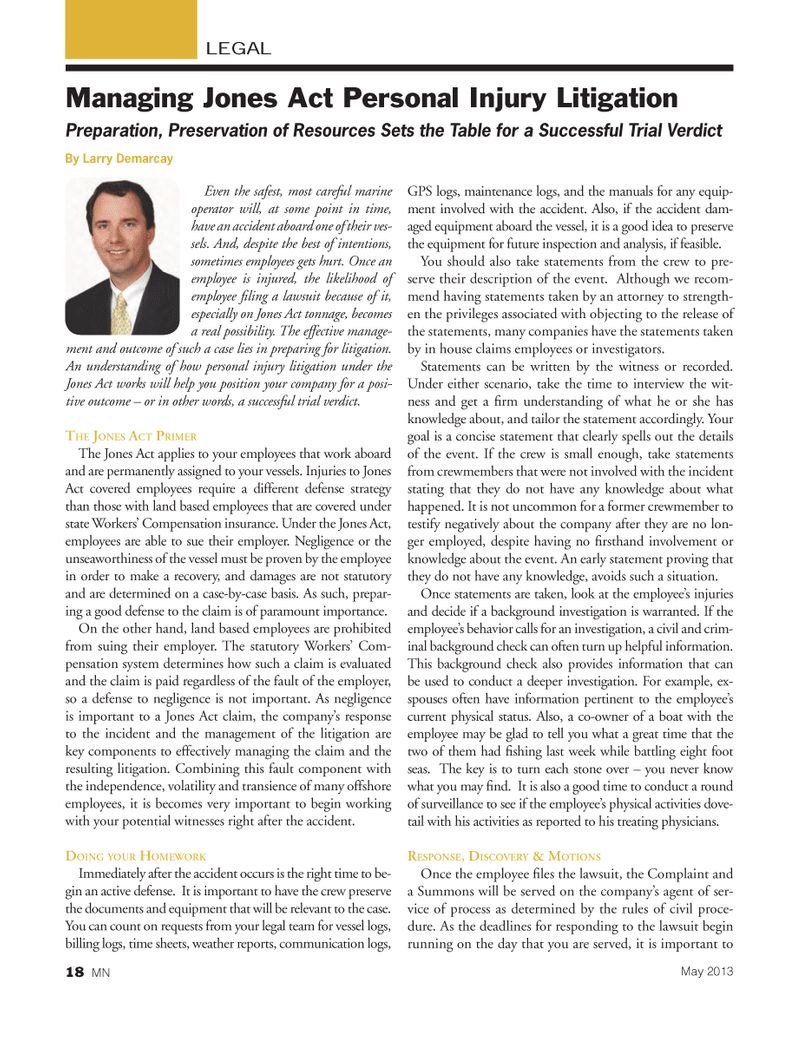
Page 18: of Marine News Magazine (May 2013)
Combat & Patrol Craft Annual
Read this page in Pdf, Flash or Html5 edition of May 2013 Marine News Magazine
Even the safest, most careful marine operator will, at some point in time, have an accident aboard one of their ves- sels. And, despite the best of intentions, sometimes employees gets hurt. Once an employee is injured, the likelihood of employee Þ ling a lawsuit because of it, especially on Jones Act tonnage, becomes a real possibility. The effective manage- ment and outcome of such a case lies in preparing for litigation. An understanding of how personal injury litigation under the Jones Act works will help you position your company for a posi- tive outcome Ð or in other words, a successful trial verdict. THE JONES ACT PRIMERThe Jones Act applies to your employees that work aboard and are permanently assigned to your vessels. Injuries to Jones Act covered employees require a different defense strategy than those with land based employees that are covered under state Workers? Compensation insurance. Under the Jones Act, employees are able to sue their employer. Negligence or the unseaworthiness of the vessel must be proven by the employee in order to make a recovery, and damages are not statutory and are determined on a case-by-case basis. As such, prepar- ing a good defense to the claim is of paramount importance. On the other hand, land based employees are prohibited from suing their employer. The statutory Workers? Com- pensation system determines how such a claim is evaluated and the claim is paid regardless of the fault of the employer, so a defense to negligence is not important. As negligence is important to a Jones Act claim, the company?s response to the incident and the management of the litigation are key components to effectively managing the claim and the resulting litigation. Combining this fault component with the independence, volatility and transience of many offshore employees, it is becomes very important to begin working with your potential witnesses right after the accident. DOING YOUR HOMEWORK Immediately after the accident occurs is the right time to be- gin an active defense. It is important to have the crew preserve the documents and equipment that will be relevant to the case. You can count on requests from your legal team for vessel logs, billing logs, time sheets, weather reports, communication logs, GPS logs, maintenance logs, and the manuals for any equip-ment involved with the accident. Also, if the accident dam- aged equipment aboard the vessel, it is a good idea to preserve the equipment for future inspection and analysis, if feasible. You should also take statements from the crew to pre- serve their description of the event. Although we recom- mend having statements taken by an attorney to strength- en the privileges associated with objecting to the release of the statements, many companies have the statements taken by in house claims employees or investigators. Statements can be written by the witness or recorded. Under either scenario, take the time to interview the wit- ness and get a rm understanding of what he or she has knowledge about, and tailor the statement accordingly. Your goal is a concise statement that clearly spells out the details of the event. If the crew is small enough, take statements from crewmembers that were not involved with the incident stating that they do not have any knowledge about what happened. It is not uncommon for a former crewmember to testify negatively about the company after they are no lon- ger employed, despite having no rsthand involvement or knowledge about the event. An early statement proving that they do not have any knowledge, avoids such a situation. Once statements are taken, look at the employee?s injuries and decide if a background investigation is warranted. If the employee?s behavior calls for an investigation, a civil and crim- inal background check can often turn up helpful information. This background check also provides information that can be used to conduct a deeper investigation. For example, ex- spouses often have information pertinent to the employee?s current physical status. Also, a co-owner of a boat with the employee may be glad to tell you what a great time that the two of them had shing last week while battling eight foot seas. The key is to turn each stone over ? you never know what you may nd. It is also a good time to conduct a round of surveillance to see if the employee?s physical activities dove- tail with his activities as reported to his treating physicians. RESPONSE, DISCOVERY & MOTIONS Once the employee les the lawsuit, the Complaint and a Summons will be served on the company?s agent of ser- vice of process as determined by the rules of civil proce- dure. As the deadlines for responding to the lawsuit begin running on the day that you are served, it is important to LEGALManaging Jones Act Personal Injury Litigation Preparation, Preservation of Resources Sets the Table for a Successful Trial Verdict By Larry Demarcay 18 MNMay 2013MN May2013 Layout 18-31.indd 18MN May2013 Layout 18-31.indd 185/3/2013 12:51:21 PM5/3/2013 12:51:21 PM

 17
17

 19
19
